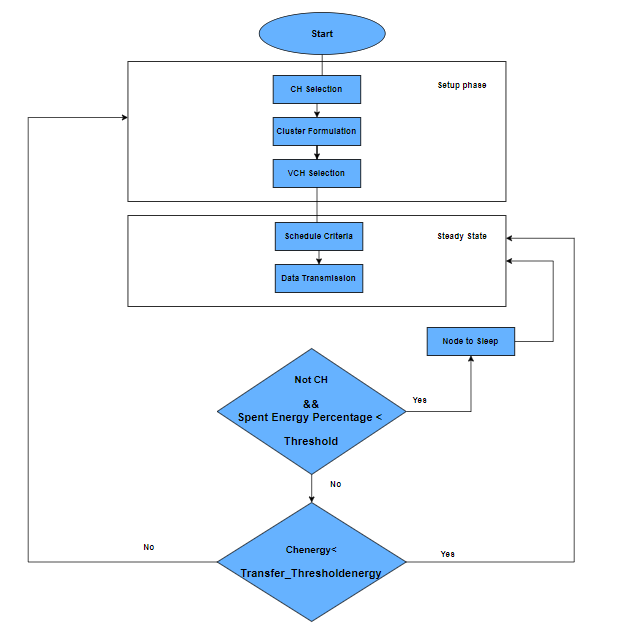Energy Optimization Efficiency in Wireless Sensor Networks for Forest Fire Detection: An Innovative Sleep Technique
Main Article Content
Abstract
Wireless Sensor Networks (WSNs) have the potential to play a significant role in forest fire detection and prevention. However, limited resources, such as short battery life pose challenges for the energy efficiency and longevity of WSN-based IoT networks. This paper focused on the energy efficiency aspect and proposed the ECP-LEACH protocol to optimize energy consumption in forest fire detection cases. The proposed protocol consists of two main components: a threshold monitoring module and a sleep scheduling module. The threshold monitoring module continuously monitors energy consumption and triggers sleep mode for nodes surpassing the predetermined threshold. The ECP-LEACH protocol offers a promising solution for improving energy efficiency in WSN-based IoT networks for forest fire detection. By optimizing sleep scheduling and duty cycles, the ECP-LEACH protocol enables significant energy savings and extended network lifetime
Article Details
References
Sangaiah AK, Javadpour A, Ja’fari F, Zavieh H, Khaniabadi SM. SALA-IoT: Self-reduced Internet of Things with learning automaton sleep scheduling algorithm. IEEE Sensors Journal. 2023.
Belhaj Mohamed M, Meddeb-Makhlouf A, Fakhfakh A, Kanoun O. Wireless body sensor networks with enhanced reliability by data aggregation based on machine learning algorithms. Advanced Sensors for Biomedical Applications. 2021;67-81.
Del-Valle-Soto C, Velázquez R, Valdivia LJ, Giannoccaro NI, Visconti P. An energy model using sleeping algorithms for wireless sensor networks under proactive and reactive protocols: A performance evaluation. Energies. 2020;13(11):3024.
Alzahrani E, Bouabdallah F, Almisbahi H. State of the art in quorum-based sleep/wakeup scheduling MAC protocols for ad hoc and wireless sensor networks. Wireless Communications and Mobile Computing. 2022.
Radhika S, Rangarajan P. Fuzzy based sleep scheduling algorithm with machine learning techniques to enhance energy efficiency in wireless sensor networks. Wireless Personal Communications. 2021;118:3025-3044.
Reena S. Satpute, Avinash Agrawal. (2023). A Critical Study of Pragmatic Ambiguity Detection in Natural Language Requirements. International Journal of Intelligent Systems and Applications in Engineering, 11(3s), 249–259. Retrieved from https://ijisae.org/index.php/IJISAE/article/view/2681
Soni G, Selvaradjou K. Performance evaluation of wireless sensor network MAC protocols with early sleep problem. International Journal of Communication Networks and Distributed Systems. 2020;25(2):123-144.
Annabel LSP, Murugan K. Traffic-based energy efficient MAC protocol for wireless sensor networks. International Journal of Information and Communication Technology. 2016;8(2/3):249.
Liu C, Huang PEI, Xiao LI. TAS-MAC: a traffic-adaptive synchronous MAC protocol for wireless. 2016;12(1):1.
Xie R, Liu A, Gao J. A residual energy aware schedule scheme for WSNs employing adjustable awake/sleep duty cycle. Wireless Personal Communications. 2016;90(4):1859-1887.
Ana Oliveira, Yosef Ben-David, Susan Smit, Elena Popova, Milica Mili?. Machine Learning for Forecasting and Predictive Modeling in Decision Science. Kuwait Journal of Machine Learning, 2(3). Retrieved from http://kuwaitjournals.com/index.php/kjml/article/view/199
Luo H, He M, Ruan Z, Chen F. A duty-cycle MAC algorithm with traffic prediction for wireless sensor networks. In: 2017 4th International Conference on Information Science and Control Engineering (ICISCE). IEEE; 2017. pp. 16-19.
Prof. Sharayu Waghmare. (2012). Vedic Multiplier Implementation for High Speed Factorial Computation. International Journal of New Practices in Management and Engineering, 1(04), 01 - 06. Retrieved from http://ijnpme.org/index.php/IJNPME/article/view/8
Usha NS, Hassen M, Saha S. Efficient duty cycle management for reduction of energy consumption in wireless sensor network. In: 2017 2nd International Conference on Electrical & Electronic Engineering (ICEEE). IEEE; 2017. pp. 1-4.
Bouachir O, Ben MA, Touacti F, Crescini D. EAMP-AIDC – energy-aware MAC protocol with adaptive individual duty cycle for EH-WSN. In: 2017 13th International Wireless Communications and Mobile Computing Conference (IWCMC). IEEE; 2017. pp. 2021-2028.
Jemili I, Ghrab D, Belghith A, Mosbah M. Context-aware broadcast in duty-cycled wireless sensor networks. International Journal on Semantic Web and Information Systems. 2017;13(3):48-67.
Guerroumi M, Pathan AK, Derhab A, Badache N, Moussaoui S. MMSMAC: a multi-mode medium access control protocol for wireless sensor networks with latency and energy-awareness. Wireless Personal Communications. 2017;96(4):4973-5010.
Mickus T, Mitchell P, Clarke T. The emergence MAC (E-MAC) protocol for wireless sensor networks. Engineering Applications of Artificial Intelligence. 2017;62(1):17-25.
Haqbeen JA, Ito T, Otsuka T, Arifuzzaman M. Traffic adaptive hybrid MAC with QoS driven energy efficiency for WSNs through joint dynamic scheduling mode. In: 2018 19th IEEE/ACIS International Conference on Software Engineering, Artificial Intelligence, Networking and Parallel/Distributed Computing (SNPD). IEEE; 2018. pp. 252-258.

